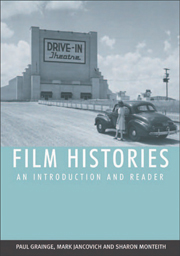Book contents
- Frontmatter
- Contents
- Preface
- Part I Film History from its Origins to 1945
- Part II Film History from 1946 to the Present
- 13 Postwar Challenges: National Regeneration, HUAC Investigations, Divestiture and Declining Audiences
- 14 The Politics of Polarisation: Affluence, Anxiety and the Cold War
- 15 Cinematic Spectacles and the Rise of the Independents
- 16 New Waves, Specialist Audiences and Adult Films
- 17 Radicalism, Revolution and Counter-Cinema
- 18 Modernism, Nostalgia and the Hollywood Renaissance
- 19 From Movie Brats to Movie Blockbusters
- 20 The Exhibitors Strike Back: Multiplexes, Video and the Rise of Home Cinema
- 21 Postmodernism, High Concept and Eighties Excess
- 22 Cults, Independents and ‘Guerrilla’ Filmmaking
- 23 From Cinemas to Theme Parks: Conglomeration, Synergy and Multimedia
- 24 Globalisation and the New Millennium
- Bibliography
- Copyright Acknowledgements
- Index
18 - Modernism, Nostalgia and the Hollywood Renaissance
from Part II - Film History from 1946 to the Present
Published online by Cambridge University Press: 05 August 2013
- Frontmatter
- Contents
- Preface
- Part I Film History from its Origins to 1945
- Part II Film History from 1946 to the Present
- 13 Postwar Challenges: National Regeneration, HUAC Investigations, Divestiture and Declining Audiences
- 14 The Politics of Polarisation: Affluence, Anxiety and the Cold War
- 15 Cinematic Spectacles and the Rise of the Independents
- 16 New Waves, Specialist Audiences and Adult Films
- 17 Radicalism, Revolution and Counter-Cinema
- 18 Modernism, Nostalgia and the Hollywood Renaissance
- 19 From Movie Brats to Movie Blockbusters
- 20 The Exhibitors Strike Back: Multiplexes, Video and the Rise of Home Cinema
- 21 Postmodernism, High Concept and Eighties Excess
- 22 Cults, Independents and ‘Guerrilla’ Filmmaking
- 23 From Cinemas to Theme Parks: Conglomeration, Synergy and Multimedia
- 24 Globalisation and the New Millennium
- Bibliography
- Copyright Acknowledgements
- Index
Summary
During the late 1960s and early 1970s, the United States was torn by internal conflict as divisions between young and old, black and white, and left and right became increasingly polarised. As a result, it is hardly surprising that the Hollywood cinema of this period displayed so many tensions and contradictions. While this can be seen as the period of Hollywood modernism, in which a series of films and filmmakers displayed the influence of the international art cinema, it can also been seen as one in which Hollywood cinema incorporated other cinemas, containing their threat by absorbing that which was threatening. In political terms, this can also be seen as both an era of political radicalism in which a whole series of aspects of American culture and society were criticised and as one of conservatism in which there was an attack on the claims and gains made by the left.
In the mid-1960s, the industry was threatened by a series of costly financial failures such as the musicals Dr Doolittle (1967) and Star! (1968). As a reaction to its declining audiences and in the aftermath of some major hits such as The Sound of Music (1965), the industry had invested heavily in a series of big budget productions many of which seriously underperformed and by 1969, the industry as a whole was in serious financial difficulty. In 1968, MGM even saw itself acquired by Kirk Kerkorian who stripped the company and sold off its assets.
- Type
- Chapter
- Information
- Film HistoriesAn Introduction and Reader, pp. 408 - 434Publisher: Edinburgh University PressPrint publication year: 2007



